It’s been over a year since one of the most iconic Hearthstone expansions – Knights of the Frozen Throne – was released. With a highly anticipated theme and introduction of the most iconic Warcraft character (The Lich King), as well as multiple Icecrown Citadel bosses, the set was bound to be successful. However, without new and interesting mechanics, it would be forgotten very quickly. Luckily for us, Blizzard has nailed that part too – after dealing with a few hiccups such as 5 mana Spreading Plague, 7 mana Bonemare as well as the entire Anduin Machine Gun, Knights of the Frozen Throne turned out to be a fun experience overall.
If I had to name the most influential mechanic introduced to Hearthstone, not only from KFT, but all the way from launch, I would still say Hero cards. You know all those expensive Legendary cards that never see play and don’t even “feel” Legendary? In the case of Death Knight Heroes, they’ve nailed that part. Not only do they all feel powerful, they ARE powerful. Every single one of them has been played in their respective class, and many of them are still staples.
The final question remains – were the Death Knight Heroes a blessing or a curse for the game? On the one hand, introducing such powerful cards, especially the ones that offer “infinite value”, turned the balance of the game upside down – many of the slower decks had to rely on them to win games, so draw RNG played an even bigger factor than before. On the other hand, the cards are fun to play, feel impactful enough for their Legendary status and high mana cost and made a lot of decks you would never expect to see completely viable.
In this article, I will take a closer look at each one of them, and try to rank them from the worst to the best. Ranking is based on their overall performance and impact they made throughout the last year, not on how strong they are right now. However, keep in mind that those Hero cards were so powerful that “worst one” doesn’t necessarily mean “bad”. They were all good, some were just better than the others, some didn’t find the right deck to be played in etc. But without further ado, let’s proceed to the main part of this article – ranking.
9. Scourgelord Garrosh
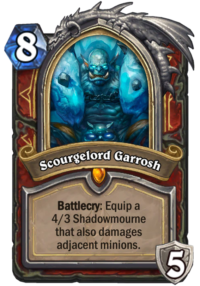
Something had to open the ranking, and sadly for the Warrior players, that card has to be a Scourgelord Garrosh. Of course, it’s not a bad card per se, and it has seen some play, but I had to pick the worst one.
Scourgelord Garrosh was a weird card in general, mostly because it was hard to find a deck it would really fit into. Good weapon (3x 4 damage every turn for three turns was massive against any board flood deck) and Whirlwind Hero Power seemingly fit into a more Midrange/Tempo deck, but the 8 mana cost and the fact that such decks didn’t really take off made players try it out in a slower Warrior builds. At the same time, slower Warrior builds didn’t necessarily want it, because they didn’t necessarily want to change their Armor Hero Power, and the card just didn’t feel like it had enough impact.
I feel like Hero Power was the main reason why this card wasn’t very popular. The weapon was really good, but having a 2 mana Whirlwind on demand is not something you expect from your Hero card, especially when you compare it to creating a Zombeast (infinite value), ping that summons a Water Elemental on kill, or 3 damage to any target and Lifesteal. While the Whirlwind effect was good in some aggressive matchups, most of the games were already decided by the time it came into action. Having an activator for Grommash Hellscream or Rotface was fine, but it’s not like it was hard to activate them without the Hero card.
So in the end, Scourgelord Garrosh hasn’t seen much play in meta decks. I’ve seen some Quest Warriors teching it in when Even Paladin (and later Odd Paladin) was very popular in The Witchwood, but other than that, it was mostly seen in decks such as Dead Man's Hand Warrior or Recruit Warrior. Despite having spikes of popularity, they were always off-meta. And it’s not like Warrior just didn’t need a Hero card – Dr. Boom, Mad Genius is now a Warrior staple, even though it has almost no immediate effect. It just shows that Hero Power plays a massive role when it comes to Hero card’s power.
8. Uther of the Ebon Blade
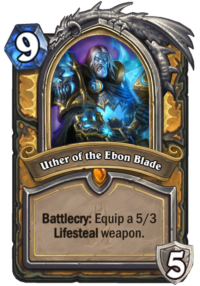
Right after Garrosh comes Uther. Funnily enough, in the pre-expansion reviews, Uther was seen as one of the strongest cards of the set. Not only did players predict that OTK combos would work, but that it’s going to be a good card in general, maybe something that brings back Control Paladin. While OTK builds worked to a certain extent, Control Paladin never came back.
For a brief amount of time, OTK Paladin was actually a pretty popular deck. Back when all you needed was a Coin or two (Burgly Bully) in order to pull off the combo with Auctionmaster Beardo, the deck was actually pretty scary, especially against players who didn’t know exactly how to play against it. I wouldn’t call it a meta deck even back then, but it had its time in spotlight.
Now, it’s not like the combo was completely dead after the rotation – it was just much more difficult to pull off. You needed bounce and/or copy cards, such as Zola the Gorgon and Ancient Brewmaster (technically the Youthful version would be better, but it gets pulled out of your deck by Call to Arms). You just bounce the necessary Horsemen back into your hand, and then play them all at once. The main problem with this is how slow it is – not only you have to wait until Turn 9 to even play Uther, but then depending on the RNG, you might have to spend another 5+ turns trying to bounce the correct 2/2’s. Still, pretty recently Thijs has made the deck work, climbed to a high Legend rank and even took it to HGG as a part of team Netherlands. Pretty impressive feat, but the despite its brief popularity, it’s nowhere to be seen once again.
So far I’ve only focused on the Hero Power (which is obviously the reason to play it in an OTK deck), but a big part of the Uther’s power lies in the weapon. Unlike the Scourgelord’s weapon, however, it was better at taking down single midrange targets and healing up – between the Armor gained from turning into a Death Knight and healing from the weapon, Paladin could regain 10 health immediately, as well as 10 more over the next two turns. Between the weapon and a solid Hero Power (upgrading the Recruits from 1/1 to 2/2 was okay, but the fact that you put opponent under a constant threat of dying made it even better) it would seem that Uther of the Ebon Blade will be a great card, just like it was expected. However, context is important – at the time when Control Paladin was already a solid deck, Uther would absolutely dominate. But it simply wasn’t enough to bring back a dead deck, especially since other classes also got their DK’s, some of which provided infinite value.
7. Thrall, Deathseer
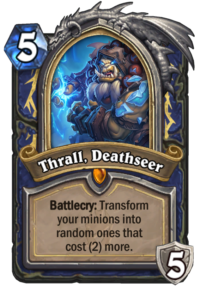
Evolve mechanic was first introduced back in Whispers of the Old Gods with, well, Evolve (as well as Master of Evolution), but it didn’t really take off until a year later – Journey to Un’Goro. Token/Evolve Shaman came out of nowhere and became one of the strongest decks on the ladder. The infamous Doppelgangster + Evolve combo was only a part of the reason why it was so strong. It could create massive board swings, utilize understatted minions with powerful Battlecries and then upgrade their body etc.
And so, Blizzard has decided to pick Evolve for the effect that came with Shaman’s Death Knight card. And it worked really well – having an additional way to evolve minions, and then a pretty cool Hero Power was worth it not only in Evolve builds, but also in other Midrange Shaman decks (they weren’t really common, but you could stumble upon one from time to time). Back then, despite being the cheapest Death Knight, a Hero card that offered least value (which was still a lot for 5 mana, don’t get me wrong), it was one of the strongest ones. However, the deck suffered from some issues. The problem was that besides this card, Shaman didn’t get anything else and failed freeze synergies will haunt Shaman players for a long time. The deck was still relevant throughout Knights of the Frozen Throne, but when Kobolds & Catacombs came and Evolve Shaman got a new class card again (Corridor Creeper was also a great card in the deck, but it was a great card in many other decks too) – Unstable Evolution – which was cool, but not as good as Evolve for what the deck was trying to do. And so, the deck and Thrall, Deathseer have disappeared from the radar for a while.
The card was brought back to life again very recently, in Boomsday Project, when the likes of Ike, Crane and Zalae were piloting “Tempo Shudderwock Shaman” to the higher ranks. The deck actually uses both of the Hero cards (because Shaman got another one in The Witchwood – Hagatha the Witch), showing how powerful they can be in the right deck, even though you can’t benefit from both at the same time. It’s still not enough to push the card to higher ranking, but just enough to keep it relevant for now. With one more expansion ahead of us, it will be the last one time for Thrall, Deathseer to shine before rotating to Wild.
6. Valeera the Hollow
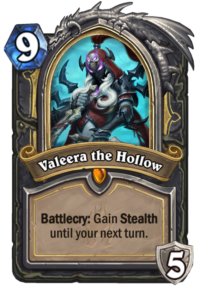
Valeera the Hollow is the only Hero card from KFT without an active Hero Power, making it stand out in that aspect. Shadow Reflection was a really interesting concept, but it didn’t really fit Rogue’s gameplan at the time. Having the ability to use a second copy of any card on the same turn is an very high value play, and has a massive combo potential. You’ve dropped that Malygos on the board, but you’re missing one burn card? No problem. Want to cycle through the deck with 2x Elven Minstrel? No problem. Want to double the value of your weapon buffs in Kingsbane deck? No problem! But the fact that the Hero costs 9 mana and has no “real” immediate effect means that it simply doesn’t fit into Aggro, Tempo or Miracle variants.
Luckily for Rogue, while value was never its class domain, combo was. Rogue was known for playing all sorts of combo decks in the past – revolving around Leeroy Jenkins, Malygos, Coldlight Oracle and more recently Kingsbane and The Caverns Below. Those combo decks have embraced Valeera and it has became a staple card in most of them. Even a turn of Stealth for your Hero, an effect that was mostly useless for faster decks, came handy in those slow, combo-oriented builds. The card was probably most useful in Kingsbane version – not only it let Rogue make a significantly bigger weapon, but she also prevented fatigue from ever occuring (by adding an extra copy of Kingsbane to the rotation). More recently, the card is most notorious for letting Quest Rogue players drop a second Giggling Inventor, for a “make a massive board with one card” play (4x 4/4 Taunt with Divine shield + 2x regular 4/4). It also lets the deck go for infinite value with Zola the Gorgon – copying herself over and over again. While not the most mana-efficient play, it lets you win some matchups in which you need as many minions as possible.
Overall, Valeera wasn’t the worst of DK Heroes, but her impact wasn’t massive. Most of the decks she was played in were off-meta, with Quest Rogue being the only exception. But even in Quest Rogue, while she’s very useful, I wouldn’t say that she defines the deck.
5. Frost Lich Jaina
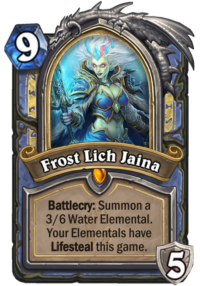
Mage’s DK landed right in the middle of the stake. But being #5 on this list doesn’t mean not being impactful, oh no. Frost Lich Jaina is a massive win condition for any Control Mage deck. While the card didn’t immediately take off, because Control Mage wasn’t an amazing archetype at the time (she was sometimes used in a so-called Burn Mage that originated in Un’Goro, but the gameplan of that deck wasn’t to outvalue the opponent), when the “Big Spell” tools were released in Kobolds & Catacombs, it quickly became a very interesting option for players who wanted to play slow decks.
The main selling point of Frost Lich Jaina is obviously her Hero Power. While the ping part doesn’t change, if that ping kills a minion, it summons a Water Elemental for the Mage. Getting one or two extra 4-drops was nice, but not game-changing. However, with an early Death Knight, Mage could easily produce 10 of them over the course of the game. Even if opponent held back his 1 health minions, it was easy to find a way to turn them into Elementals anyway. Polymorph was one of them (and later Voodoo Doll in The Witchwood), if the minion had 3 health you could Blizzard, if the minion had 5 health you could Flamestrike etc. Basically, your opponent had a choice to not play any minions (and thus probably not advance his own game plan) or let you turn them into Water Elementals.
The fact that Elementals have Lifesteal is an icing on the cake. The effect is sometimes useless vs Control decks (until you hit fatigue, at least), but it came really handy vs all kinds of burn-heavy/Aggro decks. That’s also the reason why Mage decks running Frost Lich Jaina also used Baron Geddon – it healed for all the AoE damage it dealt, often getting the player who dropped him back to full.
However, despite trying hard, Big Spell Mage never really became a mainstream deck. Even at the peak of its popularity, it had maybe a 3-4% representation on the ladder. It’s difficult to play well, it costs a lot of Dust and the games are long (and boring to some), so I guess that I could see why it never took off. Still, it was a part of the meta (and sometimes off-meta) ever since Kobolds & Catacombs, making Frost Lich Jaina a really solid Death Kinght Hero.
4. Shadowreaper Anduin
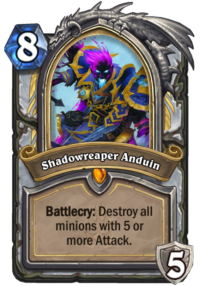
For a brief time, Shadowreaper Anduin would be an unquestionable #1 on this list. Highlander Priest controlled the entire meta for a few months, until Raza the Chained was nerfed. Its reign in Standard would end not much later anyway, because the card was rotating out 2 months after the nerfs anyway. Still, the fact that it had to be answered right before the rotation really shows how dominating the deck was.
If you didn’t play back then, or don’t remember, all you needed to do is play a deck full of singletons (so-called Highlander) with Raza the Chained (and Kazakus, of course), which used to make your Hero Power free. Then, once you’ve turned into Shadowreaper Anduin, you could repeat your Hero Power for every single card you’ve played. Since it didn’t cost you anything, you always dealt 2 damage per turn and then each of your cards had 2 extra damage attached. You could easily chip away 4-8 health from your opponent’s life total per turn, and then you had a massive combo finisher with Prophet Velen (+Mind Blast and Holy Smite). Besides the combo pieces, the deck played a lot of card draw, removal, stall and survival tools – it was a nightmare to play against, because no matter what you did, they always had some kind of answer.
Once Raza was nerfed, the deck was no longer viable. Since you had to pay 1 mana for your Hero Power anyway, it was harder to fit them into your turns, and you could no longer combo the opponent down the way you did. The trade-off you had to make (dropping all of the duplicates) simply wasn’t worth it anymore. But it doesn’t mean that it was over for Shadowreaper Anduin.
As it turned out, the card’s Hero Power was still pretty good, even with it costing 2 mana. You would usually chip down 2-4 health of your opponent per turn, or just use it as a board control tool when you needed. It was still played in Big Priest, and once the deck has rotated out, a combo version of Control Priest was created (often called Mind Blast Priest) – it was much slower and more clunky than the old Highlander, but still viable. Control Priest, while not very popular in the current meta, is still a viable deck you can meet on the ladder, and Shadowreaper Anduin is the deck’s main win condition in slower matchups.
3. Malfurion the Pestilent
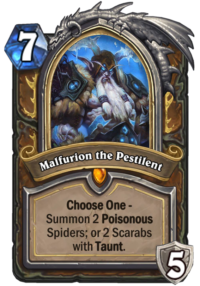
Malfurion the Pestilent is clearly the most popular Death Knight card. It was that way pretty much since it was released. Druid is one of the most popular classes ever since KFT, and this card fits into pretty much every list. So why isn’t it higher, possibly even #1? The answer is simple – despite being the most popular Death Knight card, I’m mostly ranking them by how IMPACTFUL they were. And while anyone can clearly see how good Malfurion is, in terms of impact on the class and the game in general, I wouldn’t really call it the most impactful one. See, the thing is, Malfurion the Pestilent is a great card to put into most of the Druid archetypes – Malygos, Togwaggle, Taunt, Big, Spiteful etc. But it’s never a staple card, it’s never a card that is really necessary to play the deck. It’s just a solid, well-rounded upgrade to your standard Hero. In that way, I think that Malfurion the Pestilent is also one of the most boring Hero cards, because unlike the others, it doesn’t really change the way you play the game.
The only fun part of the Malfurion is actually a choice. First, you have to make (sometimes obvious, sometimes very difficult) choice at the beginning – do you go for 2x 1/5 Taunt or 2x 1/2 Poisonous? The first mistake a lot of players make is going for Taunts most of the time, where even against Aggro, you’d often rather have the Poisonous guys. 1 attack of Taunts means that they might be able to clear them while keeping every minion alive, but Poisonous will always kill something (or they will have to make an awkward turn trying to clear them). But then, once you turn into DK, you once again make a choice each turn – +3 Attack vs +3 Armor. That choice is usually easier, but not as much as you might think. Especially in the fatigue scenario, you might need to calculate everything multiple turns ahead – will damaging your opponent be better than gaining health yourself, or vice versa?
Overall, Malfurion the Pestilent was played in nearly every single Druid archetype (if not EVERY single Druid archetype) ever since it was released. Because it will be good no matter whether you want to go aggressive or defensive, no matter if you need to use it to clear the board or deal damage to the opponent, no matter if you’re playing him for health gain or to get board presence. It’s a very flexible and very strong Hero card, and I can imagine that he will continue to see play in every Druid build until it rotates out.
2. Deathstalker Rexxar
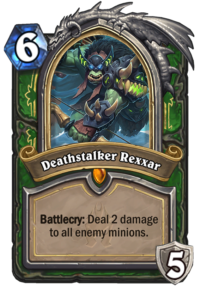
If we were ranking the Death Knight cards by how fun they are to play with, I would have to put Rexxar at #1. It’s one of the best things that has happened to Hunter. A class that previously revolved around aggression in one form or the other finally had an amazing value tool and a reason to go slower. Of course, it doesn’t mean that a Control Hunter was created (I mean, some people have attempted it, but it doesn’t really work) – Deathstalker Rexxar was just slammed into Midrange decks like Spell Hunter or Deathrattle Hunter in order to activate a full Control mode when necessary. The best thing about Deathstalker Rexxar is that a single card can completely change your approach to the matchup. You don’t need to tech in 5 different cards to fight against Control – one is enough. There’s no way to counter it, or play around it – once Hunter drops it, he will give even the slowest decks a run for their money in terms of value. No deck can really outvalue a Turn 6 Deathstalker Rexxar. Of course, it doesn’t mean that a T6 Rexxar always wins the game – some slower decks can still out-tempo it (because for the most part, the card is unbelievably slow), combo Hunter down etc.
At first, when Midrange Hunter was basically the only viable Hunter archetype back in Knights of the Frozen Throne, I was against adding Rexxar to it for the most part. Despite being fun, it didn’t perform THAT well – your main game plan was still aggression and there weren’t that many matchups in which you’d rather discover Zombeasts instead of dealing 2 damage. Later, however, everything changed. Not only a lot of new, good Beasts were introduced to the pool, the meta has changed, and Hunter has started playing slower decks that could use a win condition like that. Right now, this DK Hero is a staple in most of the builds – Secret, Spell, Deathrattle. Only builds that don’t run it are the most aggressive ones, such as Odd Face Hunter (or an Aggro Mech Hunter), but those are off-meta anyway. There’s just no reason to drop it, as it comes handy in every single matchup. Even against Aggro, where you don’t need the “infinite” value part, the 2 AoE damage and 5 Armor from Battlecry still come handy, not to mention that you have a solid chance to discover a Lifesteal or Taunt minion.
I’ve been playing with the card a lot for the last two expansions. On one hand, I’m really sad that it will rotate out relatively soon. But on the other, it might have been too strong. Playing against it doesn’t feel that good as playing as it, especially if you’re a slow, Control deck like Odd Warrior. It just doesn’t feel right that they can outvalue you with a single card. At the same time, I hope that Hunter gets more value tools / card draw so they don’t have to completely switch to the aggression again.
1. Bloodreaver Gul’dan
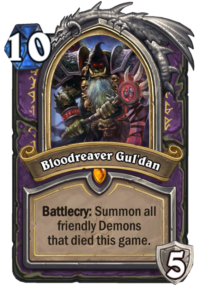
Naming the top 3 here was a really difficult choice. In terms of popularity, Malfurion would be #1. In terms of fun and how much people like it, Rexxar would be #1. But as an overall #1, I decided to pick Bloodreaver Gul’dan, because it was one of the main reasons why slow Warlock decks were playable in the last few expansions.
Since Reno Jackson has rotated out (as well as some other healing cards at the same time), slow Warlock decks were struggling to find their place. Warlock’s basic Hero Power is incredibly powerful, but punishing at the same time. Being able to draw as much as you can comes at a massive cost – you need to pay for it with your life. Between that and the fact that some cards also cost life to play (e.g. Hellfire), the class was struggling. With lots of self-damage but not many ways to heal back up, Aggro decks were preying on slow Warlocks. But not only that – even slower decks could easily rush Warlock down in the mid-late game, and that was a complete disaster. But then Knights of the Frozen Throne came and shined a ray of hope upon Warlock players. It was a good expansion for the class in general (Defile, Despicable Dreadlord), but the main reason why slower Warlock decks had a chance to comeback was Bloodreaver Gul’dan.
It was a card great in any matchup, if you could last that long. Reviving all the Demons made a massive board, you immediately gained some life, and then you could gain 3 more per turn, while clearing something or damaging your opponent. Of course, at the time it wasn’t enough – Warlocks were still dying in the mid game, before they could get to 10 mana, but some players have attempted to create Control Warlock decks for the first time in a while.
Then, Kobolds & Catacombs came and Cube Warlock became one the #1 meta deck. With all the new class cards (like Dark Pact, Kobold Librarian, Lesser Amethyst Spellstone, Skull of the Man'ari and Voidlord), as well as the neutral Carnivorous Cube, it was nearly unstoppable. And Bloodreaver Gul’dan was one of the main reasons for that, because with more early/mid game survival tools, it could finally shine. Even if you could deal with all the Voidlords, all the Doomguards, all the other non-Demon minions, even nearly kill them, it still wasn’t enough, because all of that was coming back with one card. If the only two Demons you’ve played were Doomguard & Voidlord, it’s not hard to imagine.
The deck was nerfed in The Witchwood, with Dark Pact and Possessed Lackey taking hits. But it wasn’t the end of Bloodreaver Gul’dan, no. Not only Control & Cube Warlocks were still viable (not as good as they were before, but playable), we’ve got another contender. Even Warlock, which is sort of a spiritual successor of Handlock, utilized the card very well too. While it didn’t run all of the powerful Demons, it turned out that it doesn’t have to. Even reviving 2x 2/4 Taunt and a 4/4 is enough when you’re making your Hero Power insane at the same time. Because the initial wave of Demons is something most of the slower decks can still handle – but then the constant Hero Power spam is much more difficult. Depending on the matchup and situation, it’s either a great value tool (since you can clear or at least damage some minion every turn without using a card), or a way to put them on the clock. Especially against decks with limited healing, damaging them every turn while healing yourself back up is a great way to win the game. Bloodreaver Gul’dan also gets a massive edge in any fatigue scenario, because it “swings” the health for 6 in total – damaging the opponent while healing himself. It’s like putting your opponent 3 cards deeper into fatigue (they take 4 instead of 1, 5 instead of 2 etc.) while negating the 3 turns of fatigue for yourself (of course, if you count your opponent’s Hero Power, the dynamic might be different).
All in all, I think that Bloodreaver Gul’dan is one of the most, if not THE most iconic Death Knight card, it’s one of the main reasons why slow Warlocks were brought back to life, and it made a massive impact on the class and the game in general.
Closing
That’s all folks. To be honest, placing some of the cards was very difficult. Especially the first three – I could see arguments for placing them in any order and they would definitely be sound, but that’s the way I’ve decided to tackle it in the end. All in all, Death Knight Hero cards had a MASSIVE impact on the game. The fact that they’ve all seen some kind of play, most of them were part of high tier meta decks at least for a while, and that they’re still present in around 50% of the decks on the ladder (combined) tells the story quite well. Just think how different the game will be once they rotate out. I suspect that by that time some new Hero cards will be printed (if we follow the current pattern, we’ll get one next expansion too), but some decks wouldn’t really work without the current ones.
While balance wasn’t meant to be a part of this article, I think that they overdid some of the Death Knight Heroes. Adding single cards that can get you nearly infinite value is not necessarily good, because a lot of the matchups became the race to who draws it first instead of a battle of resources. Classes without such tools (like Warrior for the long time) are also shafted, because they can’t play a viable Control deck when a single Death Knight card can outvalue them. That’s one of the problems with Hero cards in general, and both Hagatha and Dr. Boom have followed that pattern too (probably to fill for the current DKs which didn’t really have “infinite value”). On the other hand, I really like to play a deck with Hero cards, so I don’t mind seeing more – I would just like them to be toned down a bit.
Thanks for reading. Do you agree with the list? Would you put some cards in a different position? How would your Death Knight Hero ranking look like? And while we’re at it, where do you think Hagatha and Dr. Boom will place? It’s still too early to tell given that they’re more recent additions, but I would love to hear what you think. If you have any questions or suggestions, let me know in the comment section below. Good luck on the ladder and until next time!

Great article. I love the DKs as a concept and to play with them. However, it is true that many of them have a ridiculously high power level, and it’s frustrating not to draw them on time or to lose to the infinite value that some of them provide. The original Hero card, Jaraxxus, was a good but risky card. That’s how the DKs should have been. The power creep on Jaraxxus is sadly outrageous. The new hero cards (Hagatha, Dr Boom) seem to be tuned down and that’s good, I hope the next Hero cards are also not as powerful as some DKs.
I disagree with Garrosh being the worst DK. It’s true that his Hero Power is the worst (what was Blizzard thinking by giving him that crappy Hero Power? Did Jaina get Arcane Missiles for Hero Power? So why does Garrosh get Whirlwind? Shake my head… If at least it read “Deal 1 damage to all minions. Gain 1 armor for every damage dealt” then it would be decent. But not like this…). His weapon is however very powerful. DK Garrosh was a staple in the Witchwood meta, since it dealt very nicely with any kind of Rogue and Odd Paladin. Now he’s redundant because we got Supercollider, but he would still be a super good tempo tool if Midrange or Recruit Warrior were good decks. I think Thrall is slightly worse than Garrosh (you need a board and RNG can lowroll you), and Uther definitely is (win condition too unreliable).
I will be missing all of them…But, fortunately, there´s always a wild mode…
Always makes me remember that my time with Anduin, Rexxar and Jaina is on the clock. I will be incredibly sad when the rotation hits. Everyone already hates me for missing Patches but I stand by my words. I miss the little fella.
Thrall is the worst DK.
Bad list.
Compelling argument.
I like your reply but sometimes people can be so insensitive it hurts.
@Stonekeep hi man, what do you think about new hero card we will receive next expansion!?
 only for priest ! And hero card which will some how interact with dragon overall…
only for priest ! And hero card which will some how interact with dragon overall…
Cuz we will definitely get one! All heroes will get it, i mean new hero cards 2 classes already have Haggata and Dr. Boom who’s next? I thinks they will give Paladin or Priest new hero cars next expansion cuz they are pretty weak right now especially control versions of those decks. I remember old good control paladin…
Or just imagine next expansion we will get new high tempo dragons , something like in black rock mountain
Druid with his hero card has battlecry summon taunts, mage summons elemental and give elementals life steal, Warrior give mechs rush! And priest should summon dragon(s) or/and buff them or give them some value or tempo effect!
My rankings would have been
Guldan
Rexxar
Jaina
Malfurian
Anduin
Valeera
Garrosh
Thrall
Uther
you do realise that thrall might not be good atm but it was the enabler for evolveshaman, an entire archetype, one of the strongest archetype of that time.
Actually, Evolve enabled the Evolve archetype for shaman, the 1 mana spell. The DK was an addition but didnt make the archetype any better and it was dying at the time the DK came out. I think its slightly better than garrosh byt not as good as anduin or valeera by any stretch as it has seen play in some shaman decks, even currently with midrange shaman.
Just to confirm, all these are rotating out in April 2019 right?
Yes, in April the Death Knights listed above will rotate out
Hagatha and Dr Boom Mad Genius will stick around for another year though.
As always, great content and a really fun read
Thank you!